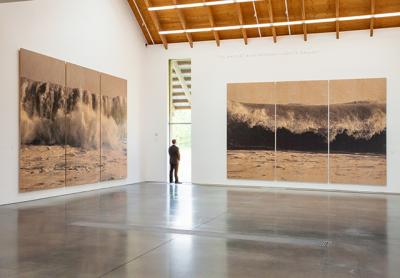Clifford Ross: Outside the Parrish, and In

The exterior south-facing wall of Water Mill’s Parrish Art Museum is a blank canvas that few artists have attempted to fill. The surface is vast, and the primary audience, occupants of the cars passing at a significant distance on Montauk Highway, might not be able to make out the details in even a billboard-sized composition.
The visual field is also dominated by a deep meadow of native plants. Look how it swallows up Roy Lichtenstein’s two “Tokyo Brushstroke” sculptures. One stands 33 feet high, the other 19 feet. Yet they are two stray reeds in the landscape.
As someone who immerses himself up to his neck in hurricane-size ocean waves, Clifford Ross is not one to back away from a challenge. Rather, he seems to take limitations as a point of departure. In so many ways, he has taken his residency at the Parrish as an invitation and opportunity to push his art and the museum’s structure to their furthermost boundaries.
His mixed-media installation “Light/Waves,” installed both inside and outside the museum, is part of the Parrish’s “Platform” series. Each year, the museum invites one or more artists to respond to the site, including the building, the property, and the regional environment, depending on their interpretation.
Mr. Ross’s installation includes two 50-foot-wide LED walls on the outside of the building facing the highway, and an 18-by-18-foot LED wall inside, as well as a set of photographs of hurricane waves, printed on multi-panel maple surfaces to form 12-by-19-foot triptychs of a single image.
Each exterior screen is about five feet longer than a school bus. Together they occupy a significant swath of the architectural “eye wash” of the Parrish’s concrete cladding without overwhelming it. A third LED wall would have fit easily, but the multiple changing images might have become confusing. In its current state, it is easy to recognize what the lights are communicating, and there is enough time to take in both panels, even constantly in flux.
Each light is a component that makes up a rather abstract image once close enough to see them at work. Viewed in motion from the highway, the waves look like real projections, reminiscent of the Hollister clothing company’s New York City store, with its facade broadcasting a feed of California surfers.
Up close the dots are visible as entities in formation, not even as components of an image but individual marks that just happen to flow together at times, forming patterns we can interpret as waves, like colored sand or some other seemingly random set of elements that combine to produce something recognizable. It is when this trick is revealed that the work becomes really interesting.
Mr. Ross has always played with the duality of abstraction and realism. He devised a special camera, modifying an aerial camera used by the military, to take exceptionally high-resolution images of a mountain he fancied in Colorado. Their resolution is so exact that a thumbnail-size section of a 6-by-10- foot image can be blown up essentially to the size of its parent without losing clarity. Later, he broke down some of these images into fragments, turning them into monochromatic blocks and reuniting them into a nonobjective whole. Then he animated some of them and put the result to music composed by Philip Glass.
It is that kind of medium-bending approach that has been employed here. Light is used in a dynamic format to communicate information that is read as waves by the eye and brain. Post-formalist in intent, the resulting piece asks questions similar to those Picasso raised when he composed an object out of shaped pieces of sheet metal, which we recognize as a guitar but which has no direct resemblance to one. Or when Chuck Close trusts his viewers to make the same leap as they process his blips and blobs of paint on a grid into something that can be read as a portrait.
Although the LED pieces are probably the sexier of the two, the gigantic wood-grain photo prints are magnificent and formidable. Mr. Ross takes the images while he is in the surf, tethered to someone on shore so he is not carried out to sea. The resulting perspective is immersive and intimidating, much greater than human scale. Looking at someone looking at the artwork, the urge to say “Watch out!” as a giant wave barrels overhead can be hard to control. What helps is that the maple grain shows through the black-and-white print, underpinning its status as an art object. That the grain “talks to” the very visible grain in the museum’s architectural wooden benches is a delightful byproduct, a way of tying the work even more closely to its environment. It also doesn’t hurt that the real ocean is just a mile away.
The artist told The Star in 2011 that his photographs in this series were printed in black and white because “form is the essential truth of a wave, not color, and in photography form is best expressed with the absence of color. Color was a distraction with the hurricane wave images.” In contrast, the LED images are in color, but in their abstraction they are completely about what form they take. It appears he discovered how to have it both ways.
The installations are on view through Oct. 15, and will be missed when they are gone. The Parrish is presenting several related programs, including an interdisciplinary symposium on water-related themes on Sept. 22. Panels, talks, and workshops will address the inspirational and natural qualities of water, in addition to the perils created by climate change.
